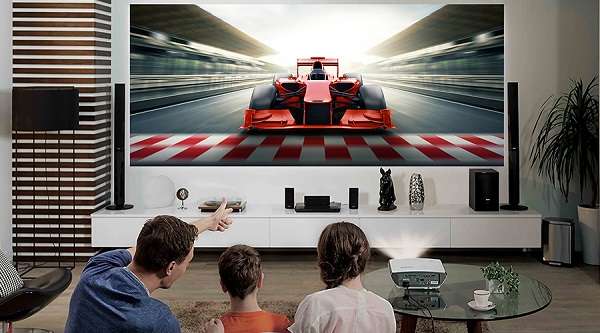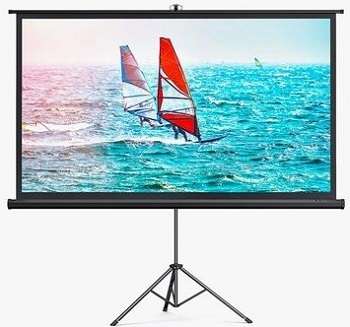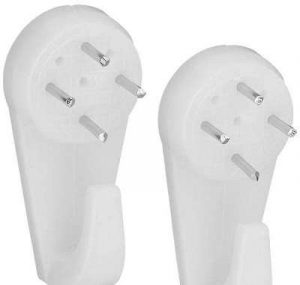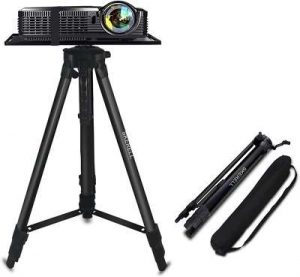Anyone who’s ever tried to mount a projector screen without drilling knows it can be a real pain. You need to find the right spot, make sure the surface is sturdy enough to hold the weight of the screen, and then hope that you’re drilling in exactly the right spot, so it hangs level.
If you don’t have a lot of experience with tools, it can be tough to get everything just right. But don’t worry – we’re here to help! This post will show you how to mount a projector screen without drilling required. Read on for all the tips and tricks you need to know.
How to mount a projector screen without drilling
1. Screen Stand with Projector Support
The easiest method to mount a projector screen without drilling is with an adjustable projector screen stand. These stands are designed to hold up your projector screen, and they work in almost any space.
This is perfect if you’re renting or moving into a new place, don’t feel comfortable drilling holes in the walls, and are looking for something super-mobile.
The one drawback to this option is that you have to adjust the height of each stand manually. If multiple people are watching your movie, someone will have to get up and adjust it for everyone else! But if portability and ease-of-use are at the top of your wish list, these stands can’t be beat.
2. Projector Ceiling Mounts
Another great way to mount a projector screen without drilling is with a projector ceiling mount, like the Peerless-AV PTM105B . This device screws into your wall or ceiling and provides additional support for your projector screen.
It’s adjustable, so you’ll have no trouble finding the best projector screen. And because the mount screws into the wall or ceiling, it’s sturdy enough to hold up even heavy projection screens.
The one drawback of this option is finding a stud in the wall to screw into. This can be tough if you’re hanging something really heavy since you’ll need to drill into the stud to get a good anchor. Plus, it’s not quite as portable as an adjustable stand.
3. DIY Projector Screen Stand
If you’re having trouble finding the perfect projector screen stand or ceiling mount, don’t worry – there are many other ways to hang up your projector screen without drilling. One of our favorites is the DIY projector screen stand.
This stand relies on tension to remain upright, so you don’t have to drill into the walls or ceiling to mount it. Plus, you can build one using readily available materials at most hardware stores.
To build your own adjustable projector screen stand, you’ll need two pieces of wood, heavy-duty zip ties, and a dowel. Using your power drill or screwdriver, screw the two pieces of wood together to create an X shape at one end of the board. Drill holes in this X-shaped piece about 3 inches apart (the spacing will depend on the size of your projector screen).
Slide the dowel through the holes in the X-shaped piece, and tighten it with zip ties. The dowel should rest about 4 to 6 inches below the board. Then, slide your projector screen onto the dowel until centered on your wall or ceiling. Finally, you’ll need to add weights (like sandbags) to the bottom of the dowel to create even more tension.
The one drawback with this DIY projector screen stand is that it isn’t adjustable, so you won’t be able to move your projector screen up and down. But if you aren’t worried about moving your projector around regularly, this homemade device will do the trick!
4. L-Shaped Wall Hangers
Two L-shaped wall hangers are another less-popular but effective way to hang up a projector screen without drilling. These devices are designed to hold up something like a mirror or painting in your bathroom, but they’ll work well for your projector screen! They can be found at most home improvement stores, and you can mount one on either side of your wall or ceiling.
Just make sure that the flat part of each L-shaped wall hanger is facing inward toward your projector screen, and you’ll be able to watch movies in no time! Like with the DIY projector screen stand, this option doesn’t let you adjust the height of your projector screen. And if you’d like to mount your projector screen on the ceiling, you’ll need to find a stud (or nail) directly above where you plan to place it.
Of course, there are other ways to hang up your projector without drilling into the walls or ceiling. These four options are just some of our favorites! If none of these ideas work for you, search for “projector screen stand, and you’ll find many other options.
5. Using Hardwall Hangers
You can make holes on the wall and hang your projector. But it’ll cost a lot of money and effort since we don’t know how hard it will be to make those holes. You may also need to spend more time fixing the hole after installation.
The best way to mount a projector is by using a hardwall hanger instead of a screen stand. Some people say that this is the best way to mount your projector without making any holes on the wall.
Using hardwall hangers, you can also hang your projector and adjust its height and position. With this adjustable projector ceiling mount, you’ll be able to watch movies comfortably with no blur or shaking images.
Building a projector screen stand with a hardwall hanger is pretty simple, especially if you have carpentry experience. You’ll need a hardwall hanger kit, some screws and bolts, your projector screen, and a drill.
First, attach the two pieces of wood using the screws and bolts given in the hardwall hanger kit. Then, attach the hardwall hanger to the top of the board.
6. Using Hanging Strips
If you don’t want to use hardwall hangers, you can also try hanging strips. This is what most people who mount their projector without making holes do. Hanging strips can hold your projector screen up safely and securely without damaging the wall or ceiling. You can buy them at any home improvement store, and you can get ones that will hold up to 30 pounds.
The great thing about these hanging strips is that they’ll work just as well for a projector screen stand or a DIY projector screen stand. You can also use them if you have your projector mounted on the ceiling! Just make sure not to damage your wall or ceiling before buying these strips.
7. Using a Tripod Projector Stand
You can find hanging solutions that are a bit simpler than a projector screen stand. These tripod stands let you hang up your projector without drilling into the walls or ceiling, and they’re portable as well!
Just like with a traditional projector screen stand, all you have to do is set it up, hang your projector screen on the tripod, and you’re done!
You can find this tripod stands at most home improvement stores or online. You just have to make sure that the size of the tripod stand matches the size of your projector screen. And if you want to mount your projector on a wall or ceiling, you’ll need to find a stud (or nail) directly above where you plan to place it.
8. Using a Projector Wall Mount
The cheapest way to attach your projector to the wall or ceiling is by using a projector mount. These are typically more affordable than traditional projector screen stands, so this is your best option if you want something quick and easy.
Projector wall mounts are typically made of aluminum, so they’re pretty durable and lightweight at the same time. They also require no assembly or tools to put together— just attach your projector to the mount, lift it up to the wall or ceiling, and connect it! Some projectors even come with their own projector mount, but they tend to be more expensive.
If you buy a projector mount, make sure it’s compatible with your projector first to make sure your projector fits onto the mount. You don’t want to overpay for something that won’t work! Also, be aware of how much weight your wall or ceiling can hold.
9. Brick Clamps
Using brick clamps is another option to mount your projector without making any holes. These clamps attach your screen directly to the wall or ceiling using hooks, and they’re super easy to install.
The hardest part about using brick clamps is finding one that fits your projector. You’ll need an adjustable one, preferably with quick-release hooks. If you have a fixed brick clamp, all you can do is attach it to the wall or ceiling, tighten the screws, and then hang up your projector screen.
The good thing about brick clamps is that they’re usually very affordable! You don’t need tools to put them together, so if you’re looking for an inexpensive and simple option, this is the way to go. But please make sure it’s compatible with your projector before buying!
10. Using Nail Hangers (or Screws)
Nail hangers are another excellent option if you’d like something more permanent than brick clamps or hanging strips. These attach directly onto the wall or ceiling, where you can then attach your projector screen.
Like with brick clamps, nail hangers are also pretty affordable and easy to use— but make sure it’s compatible with your projector first. Some projectors will come with their nail hanger (which might be more expensive), but if not, you can buy one at a home improvement store.
Don’t damage the wall or ceiling before buying any hanging system first! You can avoid this by finding studs to hang up your projector screen. To do this, tap on walls and ceilings to see if they’re hollow (if you hear a thudding sound), then use a stud finder to see if there’s a stud directly behind it.
11. Using Ceiling Hooks
If you want a different way to attach your projector screen, consider using ceiling hooks. These allow you to hang up the projector from the top of the ceiling, so you won’t have to drill into anything except drywall.
These are pretty affordable (usually less than $10 each), but make sure it’s compatible with your projector! You’ll need an adjustable ceiling hook that has quick-release hooks. Otherwise, this won’t work. Like with brick clamps and nail hangers, you shouldn’t attach anything to the wall until you’re sure the ceiling hook is compatible with your projector.
Before buying any of these, make sure to measure the distance from your projector to your wall or ceiling before buying anything! You need to know this before looking at project screen options. This will ensure that you get exactly what you need for a project screen resolution. It’s also good to check if your projector has VESA mounting holes, as not all projectors have these.
In general, here are a few things to keep in mind about your projector screen:
Lightweight and collapsible screens are easier to set up, but they’re also more expensive. If you’re on a budget, consider getting an affordable screen that’s less than $100. Just make sure you can set it up correctly.
EverWhite boards are considered the best option if you want a whiteboard meant for presentations. These come in many different sizes and styles, but they’re generally more expensive than other types of screens and projectors (but it is worth it!). They’re also very durable and versatile so that you can use them for many different projects.
Whiteboard film is another option you can get in either dry-erase or low tack. Coffee cup rings are easily removable with an eraser, which makes them a good choice if you want to save money and space for other things. You’ll need whiteboard markers specially formulated for low-tack film, but this is an excellent way to save money and space.
Retractable screens are arguably the most popular option since they’re easy to set up and don’t take up too much space. These come in many different sizes, shapes, and colors (including black), so you’ll never run out of options. Remember, you need to measure the distance of your projector to the wall or ceiling before buying anything!
Hanging systems are great if you want a simple setup that doesn’t require any tools. Remember that they’re only compatible with specific projectors since not all come with VESA holes on the bottom.
If you have an adjustable ceiling hook, this is also a good option since it allows you to hang the projector.
Don’t forget about brick clamps or nail hangers if you want to save money and space on your project screen! These are both commonly used, but make sure it’s compatible with your projector first.
Lastly, never attach anything to the wall without first measuring the distance of your projector from it. This is more important than ever if you’re using a hanging system or ceiling hooks! Remember that every projector and screen is different, so double-check everything before attaching any parts.
FAQ About the Mount a projector screen without drilling
Q: What is the difference between ceiling hooks and hanging systems?
A ceiling hook (or hanger) allows you to hang your projector from the top of the ceiling so that you won’t need anything else like a wire or rope. You can easily attach or detach it whenever needed, but this method does require drywall only. Also, this generally won’t work if your projector doesn’t have VESA holes.
On the other hand, a hanging system is designed to be attached to both the wall and ceiling. You’ll need at least one rope or wire for this method (one end should attach to the top while the other goes over the top), but it’s easier to set up. With this, you won’t need any drywall to attach it anywhere. It’s also very easy to detach and reattach whenever needed.
Q: What is the difference between whiteboard film and a projector screen?
A projector screen will allow you to project an image onto it from a distance, which means you’ll have a bigger image from farther away. On the other hand, whiteboard film will allow you to write or draw onto it with a dry erase marker from about 40 cm (15 inches) away.
Q: Can I use a projector screen as a whiteboard?
A projector screen can be used as a whiteboard if it has low-tack film, which is recommended for writing on with dry-erase markers. You can also get low-tack film for whiteboard films, but this may not be as smooth to write on.
Q: Is it okay to hang anything on the wall?
Yes! However, it would help to make sure that the projector and screen are compatible first. This means they should have the same VESA patterns, which is a standard way of attaching projectors to stands or wall mounts.
Q: What is the best material for a projector screen?
The best material depends on your needs. Better image quality will require high-gain screens, but they won’t work as well in a bright room due to the reflections from lights and windows.
Whiteboard films and low-tack screens will work well in a bright room, but you’ll have a harder time projecting onto it. Vinyl screens can be used anywhere without any issues, but they won’t help with the image quality whatsoever.
Q: Do all projector screen fabrics do the same thing?
No! Different materials are designed for different situations. For example, vinyl screens are best used outdoors or in bright rooms since they don’t reflect light. This makes it the perfect screen material for watching movies outside!
Whiteboard films and low-tack screens are ideal if you want to write on them with whiteboard markers, making them suitable for presentations. Finally, high-gain screens will provide the best image quality, but they won’t work as well in brightly lit rooms.
Q: What is the best projector screen size?
The best size for a projector depends on how far you will be from it and other factors like your lighting situation. If you want to use a fixed projection system, then a larger screen may be better since it will allow you to sit further away and still see the image. A smaller screen is better if you’re using a projector ceiling mount since it can be moved closer to the projector for a bigger image.
Final Verdict
There you have it – three ways to mount your projector screen without drilling. If you’re looking for a more permanent solution, we recommend using the stud finder and screws.
But if you want to be able to move your screen around or take it with you when you travel, then either of the other two methods will work just fine. What method did you choose, and how well did it work out?



